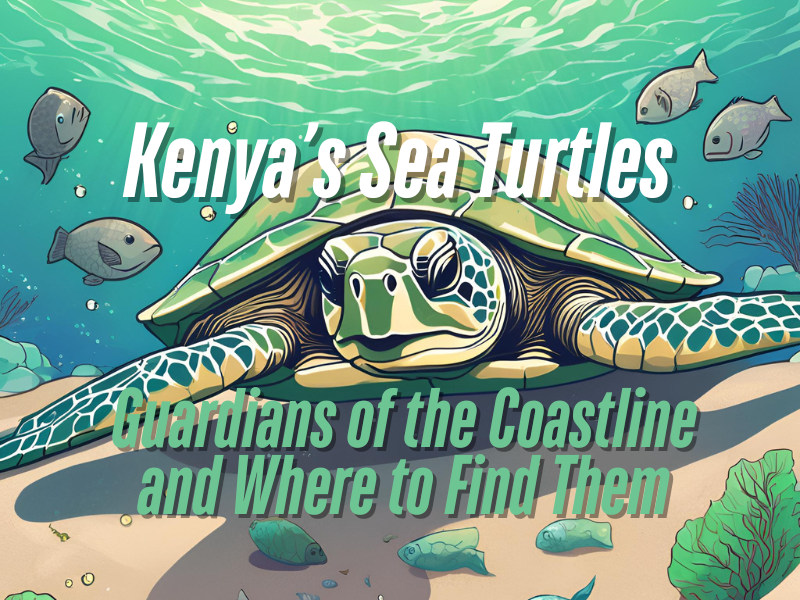Kenya’s coastline is a treasure trove of marine biodiversity, and among its most iconic inhabitants are sea turtles. These ancient mariners have glided through the Indian Ocean for millions of years, playing a vital role in maintaining the health of marine ecosystems. From nesting on sandy beaches to feeding in coral reefs, sea turtles are a symbol of Kenya’s rich coastal heritage. Let’s dive into the world of Kenya’s sea turtles and explore the key locations where they thrive.
Meet Kenya’s Sea Turtles
Kenya is home to five species of sea turtles, each with its unique characteristics and ecological role:
- Green Sea Turtle (Chelonia mydas)
- Commonly nests on Kenyan beaches.
- Herbivorous as adults, feeding on seagrass and algae.
- Hawksbill Sea Turtle (Eretmochelys imbricata)
- Found in coral reefs, feeding on sponges and jellyfish.
- Critically endangered due to poaching for their beautiful shells.
- Olive Ridley Sea Turtle (Lepidochelys olivacea)
- Known for mass nesting events called arribadas.
- Occasionally nests on Kenya’s southern beaches.
- Loggerhead Sea Turtle (Caretta caretta)
- Rarely nests in Kenya but spotted in coastal waters.
- Recognizable by their large heads and powerful jaws.
- Leatherback Sea Turtle (Dermochelys coriacea)
- The largest sea turtle species, feeding almost exclusively on jellyfish.
- Rarely nests in Kenya but are seen in deeper coastal waters.
Where to Find Sea Turtles in Kenya
Kenya’s coastline stretches over 600 kilometres, offering a variety of habitats for sea turtles. Here are the top locations where you can encounter these magnificent creatures:
1. Watamu Marine National Park and Reserve
Watamu is a sea turtle hotspot, with its pristine beaches and coral reefs providing ideal nesting and feeding grounds. The Watamu Turtle Watch program actively monitors nesting sites and rescues injured turtles, making it a hub for conservation.
2. Malindi Marine National Park and Reserve
Adjacent to Watamu, Malindi’s protected waters are another critical habitat for Green and Hawksbill Turtles. The park collaborates with local organizations to protect nesting sites and reduce threats like plastic pollution.
3. Lamu Archipelago
The secluded beaches of Lamu, Kiwayu, and Manda Islands are perfect for sea turtle nesting. The Lamu Marine Conservation Trust works with local communities to safeguard these areas.
4. Diani Beach (South Coast)
Diani’s long, sandy beaches are a favourite nesting ground for Green and Hawksbill Turtles. Local hotels and conservation groups work together to protect nests and educate tourists.
5. Shimoni and Wasini Island
The coral reefs and seagrass beds around Shimoni and Wasini provide rich feeding grounds for sea turtles. This area is part of the Kisite-Mpunguti Marine Protected Area, which safeguards critical habitats.
6. Mombasa Marine National Park and Reserve
Despite urban pressures, Mombasa’s marine park remains a vital habitat for sea turtles. Efforts are ongoing to mitigate threats like pollution and illegal fishing.
7. Kiunga Marine National Reserve (Near the Somali Border)
This remote reserve is a critical habitat for sea turtles, with pristine beaches and coral reefs. It is managed by the Kenya Wildlife Service (KWS) to protect its biodiversity.
8. Funzi Island (South Coast)
Funzi’s secluded beaches and mangrove forests provide nesting and feeding grounds for sea turtles. Local communities are actively involved in conservation efforts.
9. Vanga (Near the Tanzanian Border)
Vanga’s beaches and coral reefs are important for sea turtles, especially in the less-developed southern coast. Community-based conservation initiatives are key to protecting turtles in this area.
10. Mida Creek (Near Watamu)
This tidal inlet is rich in seagrass and mangrove ecosystems, making it a prime feeding ground for sea turtles. Local organizations monitor turtle populations and promote sustainable fishing practices.
Threats to Sea Turtles in Kenya
Despite their resilience, sea turtles face numerous threats, including:
- Habitat Loss: Coastal development and erosion destroy nesting sites.
- Plastic Pollution: Turtles often mistake plastic bags for jellyfish, leading to fatal consequences.
- Illegal Trade: Turtles are poached for their shells, meat, and eggs.
- Climate Change: Rising sea levels and temperatures affect nesting sites and hatchling survival.
Conservation Efforts in Kenya
Kenya is taking significant steps to protect its sea turtles:
- Community Involvement: Programs like Watamu Turtle Watch and Lamu Marine Conservation Trust engage local communities in conservation.
- Protected Areas: Marine parks and reserves safeguard critical habitats.
- Research and Monitoring: Scientists study turtle populations to understand their needs and threats better.
How You Can Help
- Support Conservation Organizations: Donate to or volunteer with groups like Watamu Turtle Watch or the Lamu Marine Conservation Trust.
- Reduce Plastic Use: Avoid single-use plastics to protect marine life.
- Spread Awareness: Share information about sea turtles and their conservation needs.
Conclusion
Kenya’s sea turtles are a testament to the beauty and resilience of our oceans. From Watamu’s nesting beaches to Shimoni’s coral reefs, these incredible creatures are an integral part of Kenya’s coastal ecosystems. By supporting conservation efforts and visiting these locations responsibly, we can ensure that sea turtles continue to thrive for generations to come.
Next time you’re at the coast, take a moment to appreciate these wanyama wa baharini (animals of the sea)—they’re a true treasure of Kenya’s marine heritage.

